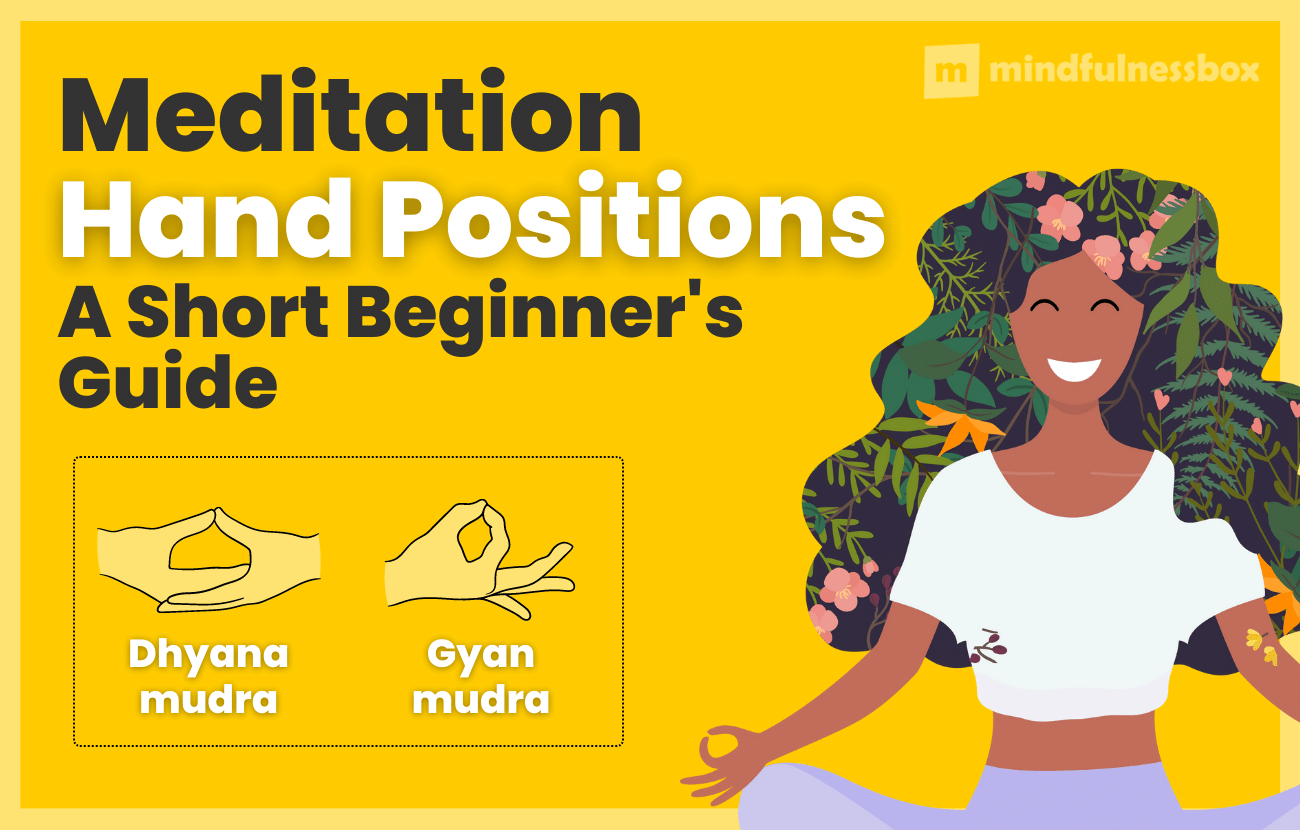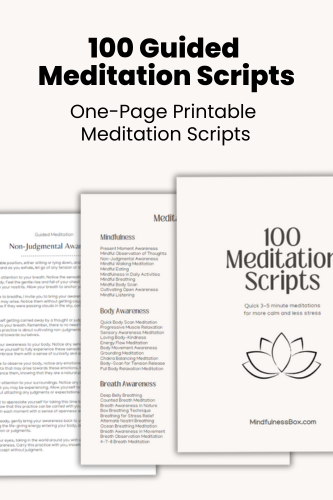When meditating, you should put your hands in the position that’s most comfortable for you. Common poses include one hand clasping the other, and each hand resting on one knee. There are also a number of ‘mudras’ you can try that carry meaning in some meditation traditions.
Whether you’re just starting meditation or have been practicing for a while, there’s a question that befuddles most of us meditators:
These 100 meditation scripts were created to help beginner and intermediate meditators practice key mindfulness concepts like self-love, forgiveness, gratitude, and inner peace.
Designed to fit into busy schedules, each meditation script lasts 3-5 minutes. Perfect for starting or closing a group meditation; for yoga, coaching, or therapy sessions; or for your personal meditation practice.
What are you supposed to do with your hands during meditation?
Gurus, monks, and even the yogi next door all seem to have impossibly cool hand placements during meditation.
It seems like there’s a “right” way to put your hands during meditation, and it can be discouraging to feel like you’re not in the club of people who understand it.
Not to worry—we’ll cover everything you need to know below.
Is it important to meditate with your hands in a certain way?
No. You can put your hands in any position that’s comfortable while meditating.
Mindfulness meditation originated from Hindu and Buddhist traditions hundreds and thousands of years ago, so there are rich spiritual traditions of putting your hands one way or another. In a spiritual context, they have meaning, but in a secular context, there’s no reason to put your hands one way or another other than your own comfort.
If you’re practicing meditation in the context of a spiritual tradition, you may prefer to adopt certain hand signs, or mudras, in alignment with that tradition. We’ll touch on that more below.
Most common hand positions for meditation
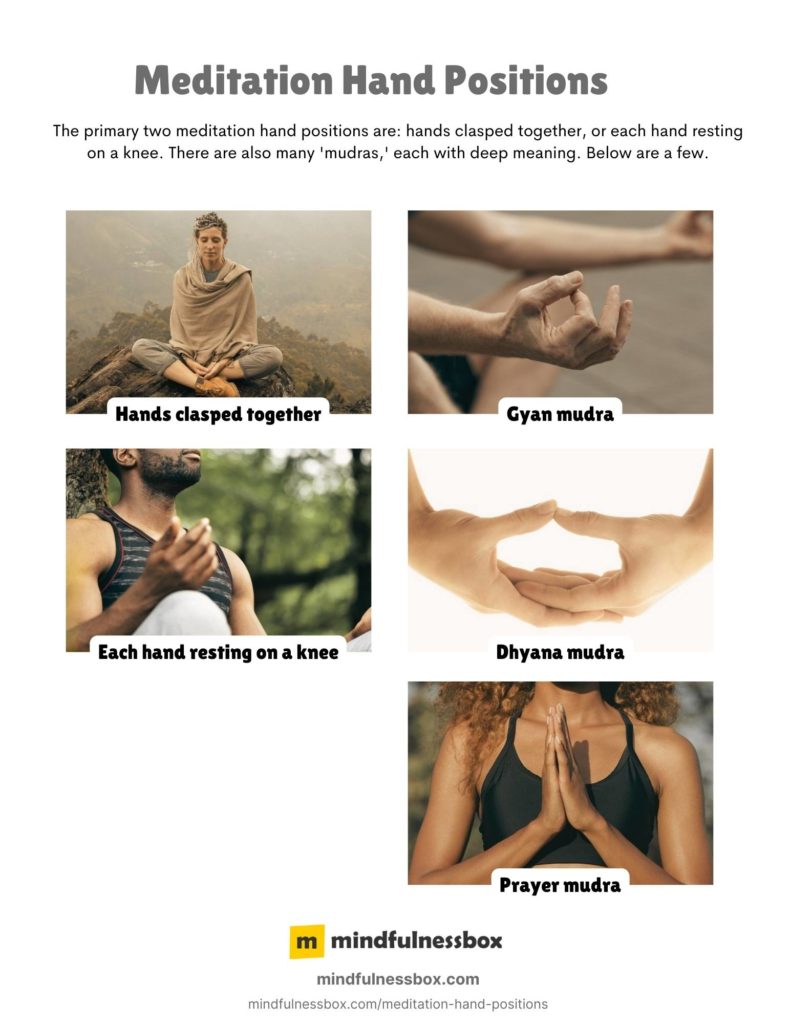
You should put your hands in any way that feels most comfortable to you.
You’ll probably find you’re most comfortable with one of these two common positions:
One hand clasping the other
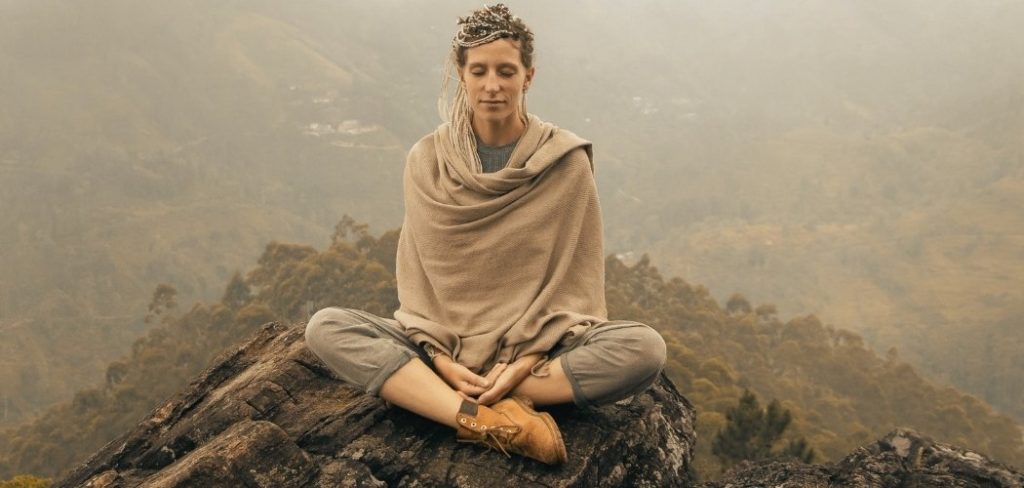
Let both hands fall naturally down, one cradling the other, with palms upward or downward depending on your preference. If you’re sitting cross-legged, your hands will fall in between your legs.
Because gravity is pulling your hands and arms downwards, this is often the most natural position to adopt because you don’t have to expend any effort to maintain it.
Just let your hands fall where they naturally do.
Each hand resting on a knee
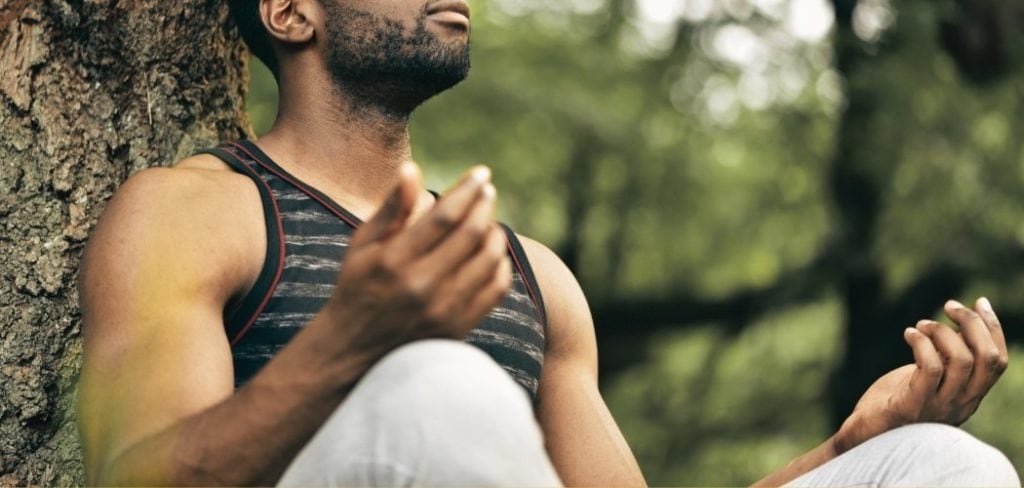
Another approach is to meditate with both hands facing up while resting on your knee
You can also put your left hand on your left knee, and your right hand on your right knee. This is another common way to place your hands during meditation.
Personally, I find this slightly harder to maintain than letting your hands fall to the middle of your torso and holding one hand with the other. There may still be some minor gravitational pull on your arms, depending on your body frame.
Your hands can be either facing up or down.
Meditation hand positions and meanings
Many hand positions for meditation come from spiritual traditions, and are imbued with meaning. These hand positions are called ‘mudras’ and are commonly found in yoga and meditation.
There is a rich tradition of mudras in Hinduism and Buddhism, with some mudras involving the hands and fingers being placed in various configurations, each with different meanings and intentions.
A short summary of the spiritual rationale behind hand positions is this:
Palms down causes your energy to flow through yourself.
Palms up shares your energy with the world.
There are a large number of mudras (hand positions) and corresponding meanings.
Here are a few examples:
1. Gyan mudra

The Gyan mudra is the classic “thumb pressing against index finger” pose that you’ve seen on many Buddha statues and in yoga classes.
The spiritual meaning of the Gyan mudra revolves around sharpening your memory and increasing your spiritual knowledge.
2. Dhyana mudra
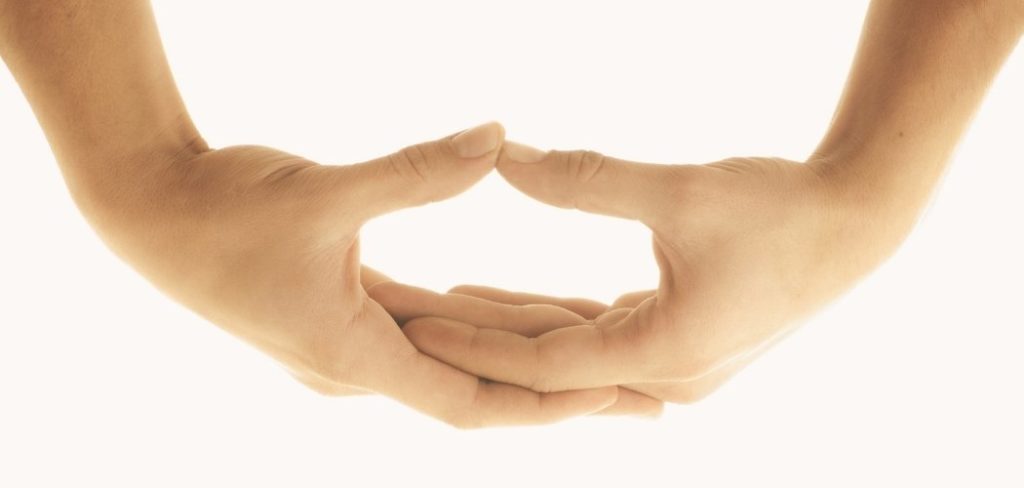
The Dhyana mudra is often how the Buddha is seen meditating in statues and paintings. It also happens to be a pretty comfortable way to place your hands: one on top of the other, resting on your lap.
The Dhyana mudra is meant to improve concentration and bring you into deeper tranquility and peace.
3. Prayer mudra
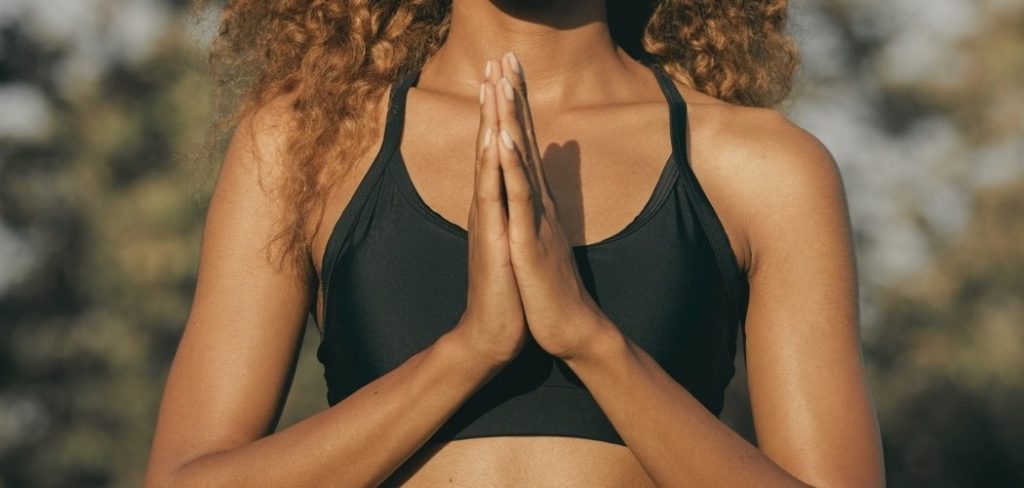
You’ll recognize this one from the common depiction of praying: both hands placed palms together in the center of your chest, fingers pointing upwards.
The prayer mudra is thought to center and balance your body and energy.
Additional meditation hand positions:
Here is a list of additional mudras used in meditation and their meanings:
- Buddhi Mudra (Intuition Gesture): Thumb presses on middle finger with other fingers extended. Develops intuition and inner wisdom.
- Chin Mudra (Consciousness Gesture): Thumb and index finger tips touch while hands rest on knees. Enhances awareness and grounding.
- Jnana Mudra (Knowledge Gesture): Tip of thumb touches tip of index finger, other fingers straight. Aids wisdom, understanding and perception.
- Anjali Mudra (Reverence Gesture): Palms pressed together at heart center. Expression of respect, devotion or prayer.
- Varada Mudra (Generosity Gesture): Palm faces out with fingers pointing down, symbolizing charity and compassion.
- Prana Mudra (Vitality Gesture): Tips of thumb, ring finger and little finger touch while other fingers are extended out. Increases vitality and reduces fatigue.
- Shuni Mudra (Patience Gesture): Thumb and middle finger tips touch while other fingers remain straight and relaxed. Develops mental patience and control.
Meditation finger position
What about your fingers? What should they be doing during meditation?
Some hand positions for meditation, like those described above, invite you to touch your fingers together or practice other finger positions for meditation. These hand positions have been captured in the popular imagination as the “right” pose for meditation.
However, there’s no specific way you need to position your fingers, unless you’re experimenting with one of the meditation mudras above.
Try and keep your fingers still. But if you need to, it’s okay to move them if you feel pain or need to scratch an itch.
Why do my hands get hot during meditation?

Your hands get hot because blood flow changes during meditation.
One thermal imaging report showed a mediator’s head, hands and other extremities becoming warmer during meditation (above). This is normal, and it shouldn’t cause any pain.
With longer meditation sessions, you might find that your hands start to get sweaty, hot, or uncomfortable. If you find that your hands are getting too hot, you may want to adjust your hand position while meditating so that it’s more comfortable for you.
The final word on how to place your hands during meditation
While there’s no shortage of opinions on which hand poses for meditation should be used, here’s the bottom line:
There is no best hand position for meditation.
Unless you feel spiritually called to put your hands a certain way, you should just focus on placing your hands in the most comfortable position possible.
Meditation is a practice that requires significant time investment over months and years. The main question of importance is how you can motivate yourself to put consistent effort over time so you can move towards a calmer, less stressed life.
So ask yourself this question:
How can I place my hands to make meditation as comfortable as possible?
Whatever the answer is, then for you, that’s the best hand posture for meditation.
Frequently asked questions
Why do you touch fingers when meditating?
There are many different reasons why people might touch their fingers when they meditate.
Some people do it because they were taught to do it by a teacher or guru, and they believe that it has special spiritual meaning. Others do it because they find that it helps them to focus and connect with their breath.
Touching your fingers can also help to keep your hands from getting too restless during meditation.
Why do my hands tingle during meditation?
When you meditate, your hands may tingle or feel numb. This is because when you’re sitting still and focusing on your breath, you’re changing patterns of blood flow throughout your body, and with certain meditation techniques, your core body temperature may rise. This also affects your extremities. This is normal, and it shouldn’t cause any pain.

My mindfulness practice kicked off in 2016 with a ten-day silent retreat. Since then, I’ve read dozens of books about mindfulness and completed hundreds of hours of meditation. Thinking about what makes humans happy, calm, and peaceful is endlessly fascinating to me.

